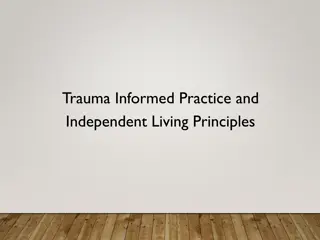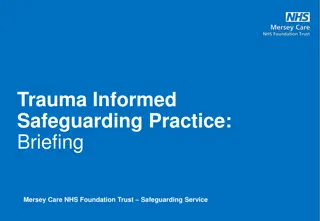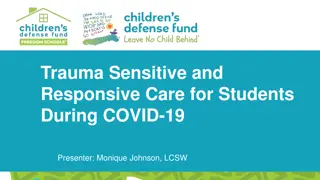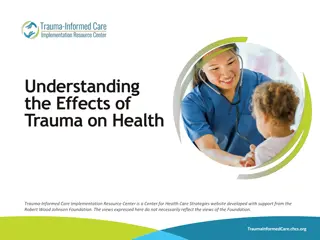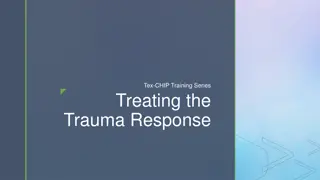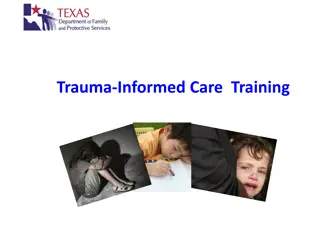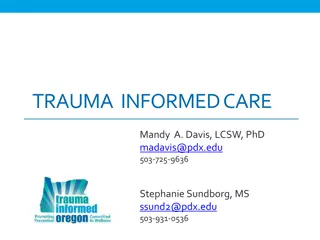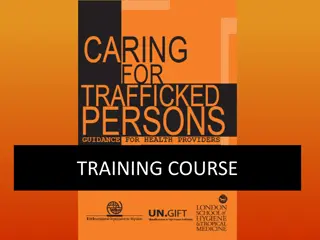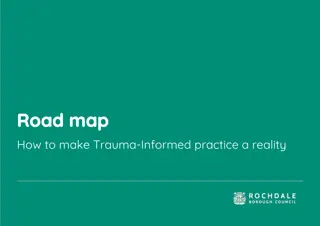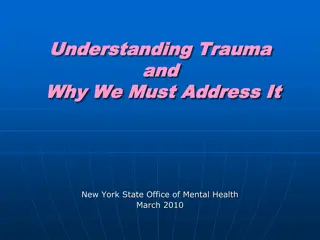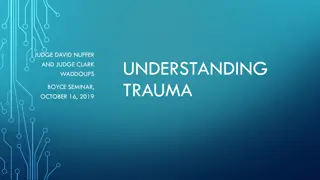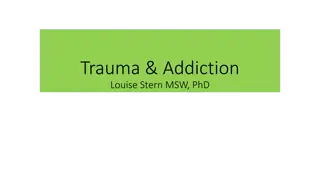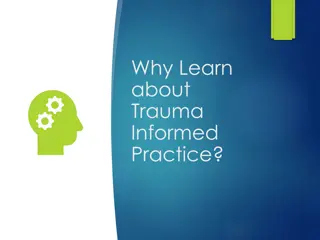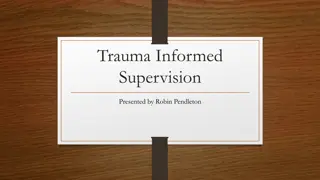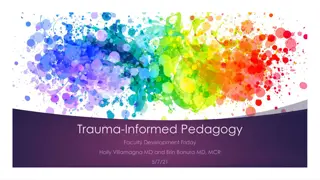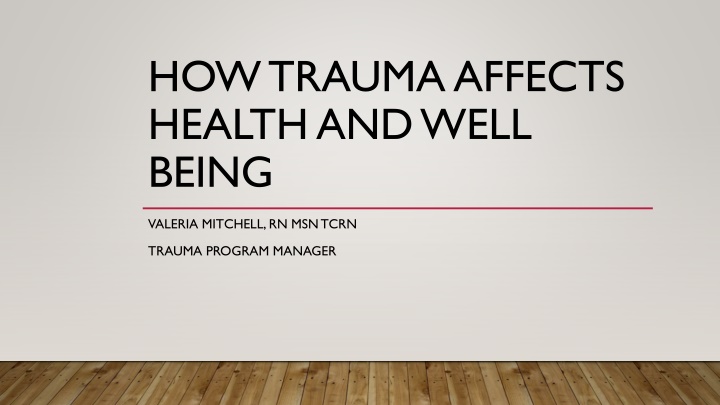
Impact of Trauma on Health and Well-Being
Explore how trauma can have lasting effects on physical, social, and emotional well-being, affecting individuals both mentally and physically. Understand the different types of trauma, such as adverse childhood experiences and community environments, and how they can shape a person's life. Discover the effects of trauma on patients and families, recognizing common signs and behaviors. Gain insights into the outcomes of lifelong trauma and how it can lead to various health issues such as COPD, depression, and liver disease.
Download Presentation

Please find below an Image/Link to download the presentation.
The content on the website is provided AS IS for your information and personal use only. It may not be sold, licensed, or shared on other websites without obtaining consent from the author. If you encounter any issues during the download, it is possible that the publisher has removed the file from their server.
You are allowed to download the files provided on this website for personal or commercial use, subject to the condition that they are used lawfully. All files are the property of their respective owners.
The content on the website is provided AS IS for your information and personal use only. It may not be sold, licensed, or shared on other websites without obtaining consent from the author.
E N D
Presentation Transcript
HOW TRAUMA AFFECTS HEALTH AND WELL BEING VALERIA MITCHELL, RN MSN TCRN TRAUMA PROGRAM MANAGER
Results from an event, series of events or set of circumstances experienced by an individual Physically or emotionally harmful or threatening TRAUMA Evokes strong feelings of fear, helplessness or horror Lasting adverse effects on individual s functioning and physical, social and emotional well being Health care environment may retraumatize the patient/family
70% of adults in the US are affected WHAT WE KNOW ABOUT TRAUMA? 90% of patients who are seen in behavioral clinics have experienced trauma Often feel intense feelings of fear, loss of trust in others, decrease personal safety, guilt and shame Impact is often deep and life shaping
ADVERSE CHILDHOOD EXPERIENCES Maternal Depression Emotional and sexual abuse Substance Abuse Domestic Violence Homelessness Incarceration Divorce
ADVERSE COMMUNITY ENVIRONMENTS Discrimination Poverty Community Disruption Lack of Opportunity Lack of economic mobility Poor housing, quality and affordability Community Violence
EFFECTS OF TRAUMA INCREASE Interpretation of stimuli as fearful DECREASE Learning and memory Brain development Startle response Short term memory Cortisol levels Calming system Blood pressure, resting heart rate and respirations Ability to form social attachments Takes less stress to trigger a stress response Ability to regulate mood
PATIENTS OR FAMILY MEMBERS WITH A TRAUMA HISTORY Irritable and hostile Very demanding Miss appointments and often present in crisis Confused and poor memory Poor self care Reluctant to discuss health issues Pain intolerance/chronic pain
OUTCOMES OF LIFE LONG TRAUMA Increase social and emotional problems COPD Depression Liver Disease Suicide Sexual transmitted disease Diabetes Substance abuse Increased risk of cancer Hypertension
Increase Increase public awareness Build Build strategic partnerships to prevent and address trauma as a community WHY CREATE A TRAUMA INFORMED SYSTEM? Promote Promote wellness, resiliency and protective factors Create Create conditions of successful adaptation Identify Identify individuals who have experienced trauma and quickly get them into appropriate services Avoid Avoid re-traumatization
Safety Trustworthiness SIX KEY PRINCIPLES OF TRAUMA INFORMED APPROACH Collaboration and Mutuality Peer Support Empowerment, Voice and Choice Cultural, Historical and Gender Issues
CREATING A TRAUMA INFORMED APPROACH Authentic Partnerships Justice Trauma and Resilience Informed resources and support Healthier Communities and Programs
01 02 03 04 ENGAGING PARTNERS CREATING SAFE SPACES MOBILIZING AND INCREASING ACCESS TO RESOURCES PROVIDING TRAUMA INFORMED CONSULTATION AND SERVICES AUTHENTIC PARTNERSHIPS
01 02 03 04 05 DEVELOPING KNOWLEDGE OF TRAUMA AND RESILIENCE ESTABLISHING MUTUAL RESPECT AND TRUST VALUING EXPERTISE HONORING VOICES-FOR US BY US USING COMMON LANGUAGE TRAUMA AND RESILIENCE INFORMED RESOURCES AND SUPPORTS
01 02 03 04 RECOGNIZE LIFE EXPERIENCES AND IMPLICIT BIAS UNDERSTANDING BIAS AND ITS EFFECT ON RELATIONSHIP WITH PATIENTS PROMOTING AND SUPPORTING JUST ORGANIZATIONS HONORING IDENTITY IN PHYSICAL ENVIRONMENT JUSTICE
01 02 03 FACILITATING PREVENTION SUPPORTING A NETWORK OF RESILIENCE VALUING HEALTHY STAFF AND SUPPORTIVE PUBLIC AND PRIVATE ORGANIZATIONS HEALTHIER COMMUNITIES AND PROGRAMS
PROVIDING TRAUMA INFORMED CARE Understand how trauma impacts our patients and family members Evaluate our current practices Assume all patients are trauma survivors Knowledge of history of childhood sexual abuse Painful chronic health symptoms feelings of helplessness, shame or guilt Extreme difficulty with medical procedures
Explain Explain before you do Be Be mindful of stress reactions PROVIDING TRAUMA INFORMED CARE Respond Respond if patient is triggered Be Be sensitive, patient ,sympathetic Share Share control Ensure Ensure privacy
This may be a person who has gone through something very traumatic..(who needs) a really safe space Because otherwise you re going to have a certain segment of patients that are going to walk away feeling as though they ve been abused all over again, quietly abused, just walking away and seeking another health practitioner, just going through cycle again, again and again maybe not understanding why and unable to voice their concern. CLOSING THOUGHT Be that kind supportive person to each of your patients.




